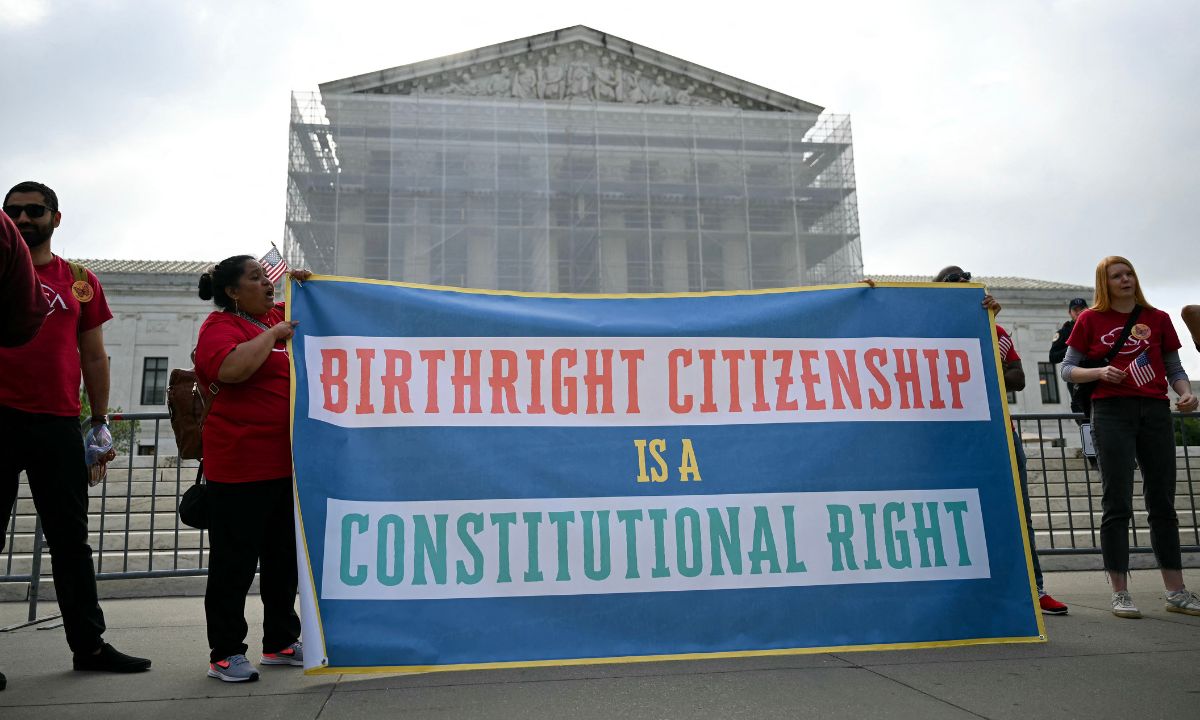SCOTUS: Lower Courts Overstepped in Nationwide Injunction on Birthright Order
Seen as a win for President Trump, Friday’s 6-3 decision sparks fear among immigrant advocates and educators about the fate of young children.

Get stories like this delivered straight to your inbox. Sign up for The 74 Newsletter
The Supreme Court handed President Donald J. Trump a major victory Friday in his attempt to undo birthright citizenship, sharply limiting federal court judges’ power to block the president’s actions nationwide on this critical issue and many others.
The 14th Amendment has long been interpreted to guarantee the right of citizenship to nearly all children born on U.S. soil. Three district courts concluded Trump’s Jan. 20 executive order taking away that right was likely unlawful and issued universal preliminary injunctions barring the order from taking effect.
In a 6-3 vote Friday, the high court’s conservative majority found the lower court judges overstepped.
“When a court concludes that the Executive Branch has acted unlawfully, the answer is not for the court to exceed its power, too,” reads the majority opinion written by Justice Amy Coney Barrett.
The court ruled that Trump’s birthright order would not go into effect for 30 days. During that time, the possibility exists that the plaintiffs could successfully reargue for another nationwide injunction under the new rules set by the Supreme Court. But if they fail, birthright citizenship may no longer be automatic in the 28 states that have not challenged the president’s directive.
Trump, appearing in the White House briefing room Friday, said “the Supreme Court has delivered a monumental victory for the Constitution, the separation of powers and the rule of law.”
The decision does not address the constitutionality of Trump’s move to end birthright citizenship, considered settled law for nearly 160 years. But it comes at a time when the president is aggressively trying to extend his powers through a barrage of executive orders that now can no longer be as forcefully blocked across the country by a single federal judge who deems them unlawful or unconstitutional. Judges have issued more than 40 such orders since Trump took office for a second term in January, the Associated Press reported.
It also coincides with the administration’s far-reaching and controversial immigration enforcement campaign that has targeted and swept up those without secure legal status, including students. Educators and advocates are particularly concerned about the fate of young children.
“The timing could not be worse, with increased ICE activity across the country,” said Adam Strom, executive director of Re-Imagining Migration. “As educators, this makes our jobs even harder. When you fear that your citizenship can be taken away, it’s very hard to learn.”
The ruling came just days after the Supreme Court decided on Monday to allow Trump to deport undocumented people to countries other than those in which they were born. Immigrant advocates say both decisions run counter to core American values.
David C. Baluarte, CUNY School of Law professor and senior associate dean for academic affairs, said if Trump is able to implement his birthright order, some children born in the United States to undocumented parents or those temporarily in the U.S. would be in great jeopardy.
“That means they will be an undocumented immigrant here, and everywhere, in perpetuity — or unless they can convince some country to give them citizenship,” Baluarte said.
Walter Olson, senior fellow at the right-of-center Cato Institute, said now is a “particularly bad” time for the high court to weaken a critical means to check the power of a “scofflaw administration.”
Olson said the president, through this particular directive, signaled from the outset of his second term that he was seeking to be “very radical” in his authority. He said the birthright issue was a remarkable choice because it was not at all up for debate.
“The law was very clear on behalf of birthright citizenship,” Olson said. “So, the executive order deserved the immediate unpopularity and outrage that came with it. It’s settled law.”
The amendment reads: “All persons born or naturalized in the United States and subject to the jurisdiction thereof, are citizens of the United States.” Trump argued it “has always excluded” people born in the United States but not “subject to the jurisdiction thereof,” including those whose mother was unlawfully present in the country and whose father was not a citizen or lawful permanent resident at the time of the child’s birth.
This same restriction applies to those children born to mothers whose presence in the U.S. is lawful but temporary, including those visiting under the Visa Waiver Program or on a student, work or tourist visa — if the father is also not a citizen or lawful permanent resident, Trump contends.
Margo Schlanger, law professor and director of the Civil Rights Litigation Clearinghouse at the University of Michigan Law School, said the Supreme Court left open three pathways through which the lower courts can block nationwide policies by the Trump administration they believe to be unlawful.
The first is through a lawsuit filed against the government by a state. The second involves a nationwide class action lawsuit, which can be cumbersome, complicated and time consuming: It’s often difficult to prove any group of people have enough in common to constitute a class. The third would allow a lower court to “set aside” a rule it deems unlawful under the Administrative Procedure Act.
Schlanger notes that every one of the three remaining pathways has “major” procedural obstacles. She predicts that the state plaintiffs will go back to their district courts and argue that even under these new Supreme Court rules, they still have grounds for a nationwide injunction because that is the only way to guarantee complete relief from an unlawful executive order.
At the same time, she said, in one or more of the other cases, private plaintiffs might try to expand to a class. Both or either type of case could land the issue back before the Supreme Court — not for procedural arguments, but to decide the issue on its merits.
“I don’t expect the Trump administration would win at that point,” Schlanger said. “What they were doing is using this case as an opportunity to restrict the authority of the non-Supreme Court federal courts.”
Randi Weingarten, president of the American Federation of Teachers, said Friday’s decision leaves Americans with one less tool to fight an “out-of-control” executive branch.
“Today, the justices have kneecapped the lower courts’ ability to protect Americans from Trump’s most pernicious policy abuses, making it far more difficult to resolve key questions by requiring additional litigation,” she said in a statement. “People need courts to protect them from this or any other administration wreaking havoc on our nation’s laws and Americans’ lives.”
Get stories like these delivered straight to your inbox. Sign up for The 74 Newsletter

;)
